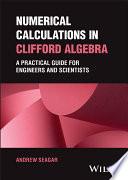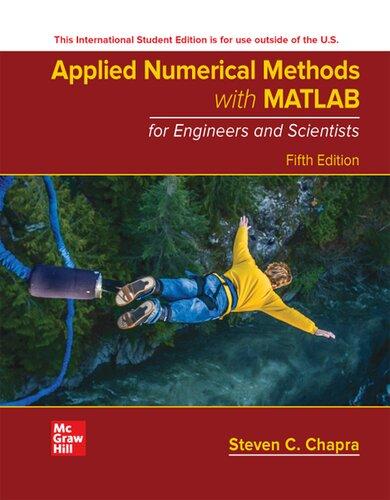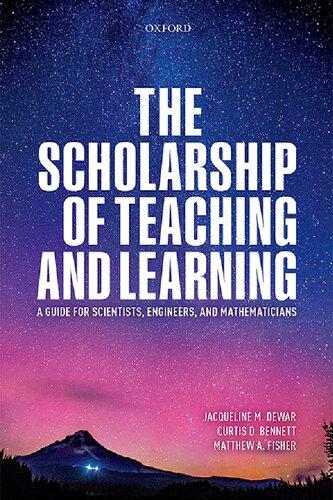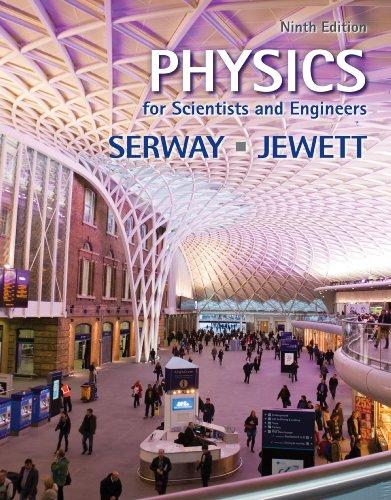NumericalCalculationsinCliffordAlgebra
APracticalGuideforEngineersandScientists
AndrewSeagar
POBox192
GriffithUniversityPostOffice QLD4222,Australia
Thiseditionfirstpublishd2023 ©2023JohnWiley&SonsLtd.
Allrightsreserved.Nopartofthispublicationmaybereproduced,storedinaretrievalsystem,or transmitted,inanyformorbyanymeans,electronic,mechanical,photocopying,recordingorotherwise, exceptaspermittedbylaw.Adviceonhowtoobtainpermissiontoreusematerialfromthistitleisavailable athttp://www.wiley.com/go/permissions.
TherightofAndrewSeagartobeidentifiedastheauthorofthisworkhasbeenassertedinaccordance withlaw.
RegisteredOffices
JohnWiley&Sons,Inc.,111RiverStreet,Hoboken,NJ07030,USA
JohnWiley&SonsLtd,TheAtrium,SouthernGate,Chichester,WestSussex,PO198SQ,UK
Fordetailsofourglobaleditorialoffices,customerservices,andmoreinformationaboutWileyproducts visitusatwww.wiley.com.
Wileyalsopublishesitsbooksinavarietyofelectronicformatsandbyprint-on-demand.Somecontentthat appearsinstandardprintversionsofthisbookmaynotbeavailableinotherformats.
Trademarks:WileyandtheWileylogoaretrademarksorregisteredtrademarksofJohnWiley&Sons,Inc. and/oritsaffiliatesintheUnitedStatesandothercountriesandmaynotbeusedwithoutwritten permission.Allothertrademarksarethepropertyoftheirrespectiveowners.JohnWiley&Sons,Inc.isnot associatedwithanyproductorvendormentionedinthisbook.
LimitofLiability/DisclaimerofWarranty
Whilethepublisherandauthorshaveusedtheirbesteffortsinpreparingthiswork,theymakeno representationsorwarrantieswithrespecttotheaccuracyorcompletenessofthecontentsofthisworkand specificallydisclaimallwarranties,includingwithoutlimitationanyimpliedwarrantiesofmerchantability orfitnessforaparticularpurpose.Nowarrantymaybecreatedorextendedbysalesrepresentatives,written salesmaterialsorpromotionalstatementsforthiswork.Thisworkissoldwiththeunderstandingthatthe publisherisnotengagedinrenderingprofessionalservices.Theadviceandstrategiescontainedhereinmay notbesuitableforyoursituation.Youshouldconsultwithaspecialistwhereappropriate.Thefactthatan organization,website,orproductisreferredtointhisworkasacitationand/orpotentialsourceoffurther informationdoesnotmeanthatthepublisherandauthorsendorsetheinformationorservicesthe organization,website,orproductmayprovideorrecommendationsitmaymake.Further,readersshould beawarethatwebsiteslistedinthisworkmayhavechangedordisappearedbetweenwhenthisworkwas writtenandwhenitisread.Neitherthepublishernorauthorsshallbeliableforanylossofprofitorany othercommercialdamages,includingbutnotlimitedtospecial,incidental,consequential,orother damages.
LibraryofCongressCataloging-in-PublicationData:
Names:Seagar,Andrew,author.|JohnWiley&Sons,publisher.
Title:NumericalcalculationsinCliffordalgebra:apracticalguidefor engineersandscientists/AndrewSeagar.
Description:Hoboken,NJ:Wiley,2023.|Includesindex.
Identifiers:LCCN2022053609(print)|LCCN2022053610(ebook)|ISBN 9781394173242(hardback)|ISBN9781394173266(adobepdf)|ISBN 9781394173259(epub)
Subjects:LCSH:Cliffordalgebras.|Algebra–Dataprocessing.
Classification:LCCQA199.S432023(print)|LCCQA199(ebook)|DDC 512/.57–dc23/eng20230203
LCrecordavailableathttps://lccn.loc.gov/2022053609
LCebookrecordavailableathttps://lccn.loc.gov/2022053610
Coverdesign:Wiley
Coverimage:©JStudios/GettyImages
Setin9.5/12.5ptSTIXTwoTextbyStraive,Chennai,India
ToCathy,Laura,JonandAxil
Contents
ListofFigures xv
ListofTables xix
Preface xxi
PartIEntitiesandOperations 1
1Introduction 3
1.1Operations 3
1.2History 4
1.3AlternativeForms 5
1.4Naming 6
1.5Structure 7
1.5.1Algebraic 7
1.5.2Numeric 8
1.6Entities 11
References 12
2Input 13
2.1Syntax 13
2.2Constants 14
2.2.1SpecificTypes 14
2.2.2General 16
2.3Variables 19
2.3.1CheckingandConverting 19
Reference 23
3Output 25
3.1TreeFormat 26
3.2NumericFormats 29
3.2.1DefaultFormat 29
3.2.2DefinedFormat 31
3.3ExtendedFormats 32
3.3.1Rounding 32
3.3.2PartsofCoefficients 33
3.4SelectedComponents 35
3.5PrimitiveFormats 36
3.6RecoveredValues 38
4UnaryOperations 41
4.1Theory 41
4.1.1Negation 41
4.1.2Involution 41
4.1.3PairExchange 42
4.1.4Reversion 43
4.1.5CliffordConjugation 44
4.1.6SupplementationandPseudo-scalar 44
4.2Practice 45
4.2.1ExampleCode 45
4.2.2ExampleOutput 47
5BinaryOperations 49
5.1GeometricOrigins 49
5.1.1OuterMultiplication 49
5.1.2OrthogonalComponents 52
5.1.3InnerMultiplication 53
5.1.4Names 54
5.2MultiplicationofUnits 55
5.2.1ProgressiveandRegressiveMultiplication 55
5.2.2Outer,Inner,andCentralMultiplication 57
5.2.3MultiplicationByScalars 58
5.3CentralMultiplication 59
5.3.1PrimalUnits 60
5.3.2EvolvedandOtherUnits 61
5.3.3Numbers 62
5.4Practice 63
5.4.1ExampleCode 63
5.4.2ExampleOutput 65
5.4.3MultiplicationTables 65 References 70
6VectorsandGeometry 71
6.1Theory 71
6.1.1Magnitude 71
6.1.2Inverse 72
6.1.3Reflection 72
6.1.4Projection 73
6.1.5Rotation 73
6.2Practice 74
6.2.1ExampleCode 74
6.2.2ExampleOutput 76
7Quaternions 79
7.1Theory 79
7.1.1Magnitude 80
7.1.2Inverse 80
7.1.3ReflectionandProjection 80
7.1.4Rotation 81
7.1.5Intersection 82
7.1.6Factorisation 82
7.2Practice 83
7.2.1ExampleCode 83
7.2.2ExampleOutput 86 References 87
8PauliMatrices 89
8.1Theory 89
8.1.1RecoveryofComponents 90
8.1.2Magnitude 90
8.1.3Inverse 91
8.1.4Reflection,Projection,andRotation 91
8.2Practice 91
8.2.1ExampleCode 91
8.2.2ExampleOutput 94 Reference 95
9BicomplexNumbers 97
9.1Theory 97
9.1.1Conjugate 98
9.1.2Magnitude 98
9.1.3Inverse 98
9.1.4Reflection,Projection,andRotation 99
9.2Practice 99
9.2.1ExampleCode 99
9.2.2ExampleOutput 101 Reference 102
10ElectromagneticFields 103
10.1Theory 103
10.1.1TimeandFrequency 103
10.1.2ElectromagneticEntities 104
10.1.3DiracOperators 105
10.1.4Maxwell’sEquations 105
x Contents
10.1.5SimplifiedNotation 105
10.1.6Magnitude 106
10.1.7Inverse 106
10.1.8Reflection 107
10.1.9Projection 107
10.1.10Rotation 107
10.2Practice 107
10.2.1ExampleCode 107
10.2.2ExampleOutput 110
10.3FieldArithmetic 112
10.3.1ExtensionsBasedonQuaternions 112
10.3.2Inverses 113
10.3.3ExampleCode 115
10.3.4ExampleOutput 117 References 118
11ArraysofCliffordNumbers 119
11.1Theory 119
11.2Practice 120
11.2.1ExampleCode 120
11.2.2ExampleOutput 123 Reference 125
12PowerSeries 127
12.1Theory 127
12.1.1UserDefined 127
12.1.2Predefined 128
12.1.3Convergence 129
12.1.4Factorisation 130
12.1.5Squaring 131
12.2Practice 131
12.2.1UserDefined 131
12.2.2Predefined 133
12.2.2.1StandardConvergence 136
12.2.2.2ExtendedConvergence 141
12.2.2.3DoublyExtendedConvergence 146 References 148
13MatricesofCliffordNumbers 149
13.1Background 149
13.2Inversion 150
13.3Practice 152
13.3.1ExampleCode 152
13.3.2ExampleOutput 155 Reference 159
PartIICustomisation 161
14Memory 163
14.1MemoryUsage 163
14.2Examples 165
14.2.1MemoryTreeSparsity 165
14.2.2MemoryExpansion 170
14.2.3MemoryRecycling 171
14.2.3.1ExplicitandImplicit 171
14.2.3.2ImplicitandNested 173 Reference 175
15Errors 177
15.1UserErrors 177
15.1.1SyntaxErrorsandMessages 180
15.2SystemErrors 181
15.3Recovery 182
15.4BeneficialUsage 185 Reference 191
16Extension 193
16.1Accumulation 193
16.2Multiplication 195
16.3Transformation 197
16.4Filtration 198
PartIIIApplication 203
17Verification 205
17.1Identities 205
17.2Tests 205
17.2.1ExampleCode 205
17.2.2ExampleOutput 208 Reference 214
18LinesNotParallel 215
18.1Theory 215
18.1.1CommonPlane 215
18.1.1.1InnerProduct 216
18.1.1.2OuterProduct 217
18.1.1.3GeometricalInterpretation 217
18.1.2NoPlaneinCommon 218
18.1.2.1InnerProduct 219
18.1.2.2Solution 219
18.2Practice 220
18.2.1ExampleCode 220
18.2.2ExampleOutput 223 Reference 224
19PerspectiveProjection 225
19.1Theory 225
19.2Practice 225
19.2.1ExampleCode 225
19.2.2ExampleOutput 229 Reference 230
20LinearSystems 231
20.1Theory 231
20.2Practice 233
20.2.1ExampleCode 233
20.2.2ExampleOutput 235 References 235
21FastFourierTransform 237
21.1Theory 237
21.2Practice 238
21.2.1ExampleCode 238
21.2.2ExampleOutput 243 References 244
22HertzianDipole 245
22.1Theory 245
22.2Practice 246
22.2.1ExampleCode 246
22.2.2ExampleOutput 251 Reference 253
23FiniteDifferenceTimeDomain 255
23.1Theory 255
23.1.1AnalyticalSolution 255
23.1.2SeriesSolution 256
23.1.3AnalyticalExample 257
23.1.4NumericalDerivatives 257
23.2Practice 259
23.2.1ExampleCode 259
23.2.2ExampleOutput 265 References 270
24CauchyExtension 271
24.1Background 271
24.2Theory 272
24.2.1TwoDimensions 272
24.2.2ThreeDimensions 272
24.2.3Singularity 273
24.2.4TheTamingFunction 273
24.2.5Construction 274
24.3Practice 276
24.3.1ExampleCode 276
24.3.2ExampleOutput 281 References 284
25ElectromagneticScattering 285
25.1Background 285
25.2Theory 286
25.3Practice 288
25.3.1ExampleCode 288
25.3.2ExampleOutput 289 References 293
PartIVProgramming 295
26Interfaces 297
26.1ConfigurationandObservation 297
26.1.1Management 297
26.1.2Printing 298
26.2SimpleEntities 300
26.2.1Units 300
26.2.2Components 300
26.2.3Numbers 302
26.2.3.1EstablishingandRecoveringValues 302
26.2.3.2Functions 303
26.2.3.3AdditionandSubtraction 304
26.2.3.4Multiplication 304
26.2.3.5Geometric 305
26.2.3.6Filtering 305
26.3HigherEntities 306
26.3.1Vectors 306
26.3.2BicomplexNumbers 307
26.3.3Quaternions 307
26.3.4PauliMatrices 308
26.3.5ElectromagneticFields 308
26.4MultipleEntities 309
26.4.1Arrays 309
26.4.2FastFourierTransforms 309
26.4.3Series 310
26.4.4Matrices 310 Reference 311
27Descriptions 313
27.1Arguments 313
27.2Datatypes 313
27.3Formats 315
27.4ManualPages 316
27.4.1A–E 316
27.4.2F–J 342
27.4.3K–O 369
27.4.4P–T 387
27.4.5U–Z 468
27.5QuickReference 477
Reference 487
AKeytoExampleCodeandResults 489
Index 493
ListofFigures
Figure4.1 Negation 42
Figure4.2 Involution 42
Figure4.3 Pairexchange 43
Figure4.4 Reversion 43
Figure4.5 Supplement 44
Figure4.6 Pseudo-scalar eN fordimension n = 3 45
Figure5.1 Outermultiplicationofunequalvectors 50
Figure5.2 Outermultiplicationofequalvectors 50
Figure5.3 Lefttorightdistributionofoutermultiplicationoveraddition 50
Figure5.4 Righttoleftdistributionofoutermultiplicationoveraddition 51
Figure5.5 Anti-commutativityofoutermultiplication 51
Figure5.6 Outermultiplicationusingorthogonalcomponents 52
Figure5.7 Outerandinnermultiplicationofvectors 53
Figure5.8 Geometricbehaviourofinnerandoutermultiplicationforvectors 54
Figure5.9 Pictorialrepresentationofprogressive(∧)andregressive(∨) multiplication 56
Figure5.10 Pictorialrepresentationofcentralmultiplication 58
Figure5.11 Pictorialrepresentationofmultiplicationbyascalar 59
Figure5.12 Multiplicationoffixedvector a andvariablevector b supportedasinner andoutermultiplicationattwoendsofcentral90∘ span 60
Figure5.13 Identificationofterritorycoveredbydifferenttypesofmultiplication 70
Figure6.1 Reflectionofvector,incontextwithnegativesignature �� =−1 72
Figure6.2 Orthogonalprojectionsofvector,incontextwithnegativesignature �� =−1 73
Figure6.3 Rotationofvector 74
Figure7.1 Geometricinterpretationofunitquaternions I , J , K asbivectors 81
Figure7.2 Constructionofvectorfactorsofquaternioninplaneperpendicularto vector V83
xvi ListofFigures
Figure11.1 Triangularpulse 124
Figure11.2 Spectrumoftriangularpulse 124
Figure12.1 Clifford–Besselfunction f (x )= Cn (x ) withscalarargumentfororders n = 0 and1 134
Figure12.2 Clifford–Besselfunctionwithnon-scalarargument 134
Figure13.1 Matrixwithfiverowsandsevencolumnscontainingasub-matrixofthree rowsandfourcolumns 150
Figure17.1 NumericalerrorasfunctionofdimensionforfullCliffordnumbers 212
Figure17.2 Numericalerrorasfunctionofdimensionforvectors 213
Figure17.3 ComputationaltimeasfunctionofdimensionforfullClifford numbers 213
Figure17.4 Computationaltimeasfunctionofdimensionforvectors 214
Figure18.1 Point x closesttotwolines b a and s r (a)withcommonplane,(b)with nocommonplane 216
Figure18.2 Intersectionoftwolinesin n dimensionsatpoint x 216
Figure18.3 Solutionforscalarparameter �� asratiooftwoareas(a)asperequation, (b)geometricallyreconfigured 217
Figure18.4 Solutionforscalarparameter �� asaratiooftwoareas(a)asperequation, (b)geometricallyreconfigured 218
Figure18.5 Minimumseparationoftwolinesin n dimensionsatpoints u and v 218
Figure19.1 Shadow-plane x2 y2 ,ontowhichpoints x3 , y3 , z3 inspaceareprojectedby raysfromthesun 226
Figure19.2 Dodecahedronwithperspectiveprojection 230
Figure21.1 Sampledperiodicsignal 238
Figure21.2 Periodicspectrumofperiodicsignal 238
Figure22.1 Verticalcurrentsource Ik withinregion Ω0 oflength h andcross-sectional area A,standingverticallyattheorigin,cappedattheendswithcharge reservoirs Ω1 , Ω2 246
Figure22.2 ComponentsofHertziandipolefield 251
Figure22.3 MagnitudeofHertziandipolefield 252
Figure22.4 Hertziandipolefieldinverticalplane 252
Figure22.5 InverseofHertziandipolefieldinverticalplane 253
Figure23.1 Sinusoidalwaveform 257
Figure23.2 Observationwindow0to L forinfiniteseriesoftravellingpulses 266
Figure23.3 Gaussianpulsetravellingonecycle 266
Figure23.4 Triangularpulsetravellingonecycle 267
Figure23.5 Squarepulsetravellingonecycle 268
Figure23.6 Gaussianpulsetravelling2048cycles 268
ListofFigures
Figure23.7 Triangularpulsetravelling2048cycles 269
Figure23.8 Squarepulsetravelling2048cycles 269
Figure23.9 Squarepulseshapeafter1024cycles 270
Figure24.1 CuboctahedronwithCauchyextensionoftheelectromagneticfieldfrom points s onthesurface Σ topoints r outside 273
Figure24.2 Variableofintegration s passespointofevaluation r closeto boundary Σ 275
Figure24.3 DipolefieldanderrorinCauchyextension 281
Figure24.4 ErrorinCauchyextensionasratio 282
Figure24.5 ErrorinCauchyextensionasfunctionofresolution 283
Figure24.6 Tamed(continuouswithsymbols)anduntamed(dashed)errorsfor Hertziantamingsource 283
Figure24.7 Tamed(continuouswithsymbols)anduntamed(dashed)errorsforDirac deltatamingsource 284
Figure25.1 Relativeerrorinreducedmatrixforextendedelectromagneticfield 290
Figure25.2 Relativeerrorinproductofmatrixandinverseofextendedelectromagnetic field 290
Figure25.3 Inversiontimeformatrixofextendedelectromagneticfield 291
Figure25.4 RelativeerrorinreducedmatrixforquaternionandPaulimatrix 292
Figure25.5 RelativeerrorinproductofmatrixandinverseforquaternionandPauli matrix 292
Figure25.6 InversiontimeformatrixofquaternionsandPaulimatrices 293
ListofTables
Table1.1 Basicunaryandbinaryoperations 4
Table1.2 Equivalencebetweennotations 4
Table1.3 ConversionofoperationsbetweenCliffordandotheralgebras 6
Table1.4 ExamplesofCliffordnumbers 7
Table1.5 Basicmathematicalentities 11
Table2.1 Syntaxforconstants 14
Table4.1 Unaryoperations 42
Table5.1 Elementarybinaryoperations 50
Table5.2 Rulesforprogressive(∧)andregressive(∨)multiplication 57
Table5.3 Rulesforcentralmultiplicationbetweenunits 58
Table5.4 Rulesformultiplicationbyascalar 59
Table5.5 Rulesforcentralmultiplication xy betweenprimalunitsandscalars 61
Table5.6 MultiplicationofevolvedandotherCliffordunits x and y61
Table5.7 Multiplicationtablesforpositivesignatures 66
Table5.8 Multiplicationtablesfornegativesignatures 68
Table6.1 Geometricoperationsonvectors 72
Table7.1 Geometricoperationsonquaternions 80
Table8.1 GeometricoperationsonPaulimatrices 90
Table9.1 Geometricoperationsonbicomplexnumbers 98
Table10.1 Electromagneticentitiesintimeandfrequencydomain 104
Table12.1 PowerseriesforBessel–Cliffordfunction f (x )= Cn (x ) oforder n128
Table12.2 Pre-definedpowerseries 128
Table12.3 Evaluationoflogarithmandbinomialfunctionsasaproductofscalarand non-scalarparts 130
Table13.1 Functionprototypeofroutinetodeclarefunctionforinversionofmatrix elements 151
Table13.2 Pre-definedfunctionsformatrixinversion 151
Table14.1 Forks,branches,andleavesofbinarytree 164
Table14.2 BinarytreeforfullCliffordnumberofthreedimensions 164
Table15.1 Usererrors,A–Z 178
Table15.2 Syntaxerrors 180
Table15.3 Syntaxmessages 180
Table15.4 Systemerrors 181
Table16.1 Functionprototypeofworkerroutinetomergecomponentsintotrees 194
Table16.2 Predefinedunaryandbinaryoperationsformergingcomponentsinto trees 194
Table16.3 Functionprototypesofworkerroutinestomultiplynumbersand componentsbyapplyingthedistributionofmultiplicationover addition 196
Table16.4 Pre-definedoperationsformultiplyingtwocomponents 196
Table16.5 Functionprototypesofworkerroutinestoapplytransformationsto numbers 198
Table16.6 Pre-definedfunctionsfortransformingnumbers 199
Table16.7 Functionprototypesofworkerroutinestoapplyfilterstonumbers 200
Table16.8 Pre-definedtestsforfilteringnumbers 201
Table17.1 IdentitiesforCliffordnumbers u, v, w andvector a206
Table21.1 Limitsonfrequenciesandperiodsforsignalintermsofsampling parameters 238
Table25.1 Computationaleffortforalternativemethodsofmatrixsolutionfor electromagneticfieldproblems 287
Table27.1 Argumenttypes 314
Table27.2 Newdatatypes 314
Table27.3 Printingformats 316
TableA.1 Generalapplicationcodeandresults 490
TableA.2 SurfaceandCauchyapplicationcodeandresults 490
TableA.3 Demonstrationcodeandresults 491
Preface
Cliffordalgebraisatool,andlikealltoolsshouldonlybeusedfortaskstowhichitiswell suited.Onesignthatatooliswellsuitedtoataskisthatbyusingthetoolthetaskissimpler thanbyusingadifferenttool.However,likemosttools,withCliffordalgebrathereisthe needtoinvestsometimetodevelopproperlytheskilltouseit.
Clifforddevelopedhisalgebrawithaparticulartaskinmind,namelythesolutionof Maxwell’sequationsofclassicalelectromagnetism.Atthetimetwoothertoolswereinuse, Cartesiancomponentsandquaternions.Vectorcalculuscamelater,outofquaternions.
Cliffordcalledhisalgebraa‘geometricalgebra’.Heconstructeditfromquaternions, pinningtheirbehaviouratafundamentallevelonthealgebraoftheorthogonalelementary vectorunits ep introducedearlierbyGrassmann.Asaconsequence,inadditiontothe multiplicationofquaternions,Clifford’sgeometricalgebrainheritsthemanyandvaried multiplicationsandotheroperationssupportedbyGrassmann’sextensive1 algebra.Thelist includes(asnamedbyGrassmannatthetime)innerandoutermultiplication,progressive andregressivemultiplication,centralmultiplication,andtheunarysupplementoperation.
Today,othernamesarealsoused.Grassmannhimselfchangedoutermultiplicationto progressivemultiplicationwhenattemptingtocombinedifferenttypesofmultiplication withinasingleframework2 .Thatnamewasnotadoptedgenerally,withexteriormultiplicationnowasanotheralternative.
Regressivemultiplicationmaybefoundintheformofthe‘meet’operationwithinthe contextofcomputergraphics,whereitisusedtoformulatetheintersectionbetween geometricdescriptionsofobjects.Central(ormiddle)multiplicationiscurrentlycalled CliffordmultiplicationsomewhatlosingsightofClifford’salgebraassupportingmany kindsofmultiplication,notjustone.Grassmann’ssupplementoperationisnowcalledthe Hodgestar(orHodge’sdual)operation.
Ashavethenameschangedovertime,sohavethenotations.Grassmannhimselfused differentnotationsatdifferenttimesforthesameoperationsashisworksmatured.Takeas exampleinnermultiplication,definedbyGrassmannastheoutermultiplicationofone numberbythesupplementofanother.Atthetime,Grassmannused(square)brackets [] toindicatetheoutermultiplicationofthenumbersinbetween,andaverticalbar | to
1Themeaningof‘extensivealgebra’isinthesensethatthealgebrasupportstheextensionfromany particulardimensionalspacetothenexthigher-dimensionalspace. 2Fornow,Cliffordalgebradoesthatforus.
representthesupplementofthenumberfollowing.Thus,thenotation [ a | b ] denotesinner multiplicationastheoutermultiplicationofnumber a bythesupplementofnumber b. Today,theinnermultiplicationoftwonumbersiswritteninatleasttwonotations. Thefirstnotationis (a , b),whereGrassmann’sbracketshavebeenreplacedbyparentheses andtheverticalbarhaswitheredtoacomma.Withthisnotation,sightoftheunderlying outermultiplicationandsupplementislost.
Thesecondnotationis a ∧∗ b,wherethebracketshavebeenreplacedbytheinfixwedge operator3 ∧ toindicatetheoutermultiplicationofthenumbersoneitherside,andtheverticalbarhasbeenreplacedbytheHodgestaroperator.Thisnotationismoreinkeepingwith Grassmann’soriginal.
Someworksongeometricalgebrafocusmoreonthealgebrathanonthegeometryand moreonthetheorythanthepractice.Itisamistaketoconcentratewhollyonthealgebra becausethatlosessightofthegeometricalapplication.Itisequallyamistaketoconsider onlyvectorsbecausetheyaretoosimple,bythemselvesbeinginsufficienttorepresentthe fullgeometryoftwoorhigherdimensionalspaces.Boththealgebraandthevectorsare necessary;however,singlyortogether,theyprovideanincompletepicture.
Itisalsoamistaketotreatthealgebrawhollyasanabstraction.Itisimportanttoexamine concreteexamples.Myownviewisthatapplicationmeansnothinglessthanconceptionat anabstractlevel,designatasystemlevel,calculationatanumericallevel,andconstruction ataphysicallevelofsomeactualapparatusintendedtoperformsomeusefulfunctionsuch asamicrowaveantennatotransmitandreceiveelectromagneticradiationforthepurpose ofcommunication.
ForthecommittedbeginnertotheapplicationofCliffordalgebra,therearetwoobstacles toovercome.First,itisnecessarytoacquireaworkingknowledgeofsomeoftheabstract concepts(whichImuchprefertocalltools)inordertobeabletoformulateproblemsand theirsolutions.Foranyonefamiliarwithvectorcalculus,thatservesasagoodstartingpoint.
MovingfromvectorcalculustoCliffordalgebrainvolvesaparadigmshiftinwhich problemsinmultipledimensionsarenolongertreatedasasystemofpartialdifferential equationsinamultiplicityofsingle-dimensionalscalarvariables,butratherasasingle ordinarydifferentialequationinasinglemulti-dimensional,non-scalarvariable.
Itisnotnecessarytobecomefamiliarwithallofthetools.Forclassicalelectromagnetism, Grassmann’scentral(nowClifford)multiplicationplaystheleadingrole,withmostofthe otherkindsofmultiplicationseldomorneverused.Combiningcentralmultiplicationwith theCauchyintegral,reincarnatedinmultipledimensionsusingCliffordalgebra,provides newtoolswhicharesufficientinmanypracticalcasestoserveaseffectivereplacementsto thevectorcalculus,theHelmholtzequation,andtheGreen’sfunctions.
Secondistheknottyobstacleofnumericalcalculation.Thishastobeconvenient(orat leastnottooinconvenient),efficientenoughtoallowthesolutionofmeaningfulproblems withinacceptabletimeframes,andmostimportantly,writtenlargelybysomeoneelse.
Theworkhereattemptstoprovideabridgespanningbothoftheseobstacles.Equal importanceisgiventofundamentaltheory,practical(geometrical)application,and softwareimplementation.Thesethreecomponentsarepresentedintheformsofwritten
3Notdissimilartotheinverted‘u’symbol ∩ usedearlierbyGrassmannforthesamepurpose.
text,someequations,manyfigures,andextensiveexamplesofcomputercodeandthe correspondingoutput.
Softwareimplementationsarebasedoncomputerprogramsourcecode(writteninthe ‘c’computerprogramminglanguage)invokingindividualroutines,specificallyconstructed todoalloftheactualcalculation,fromasuite4 providedanddistributedopenlyforthatvery purpose.Whentheuserfindstheyneedtodosomethingnotalreadyprovided,thereisno significantobstacletoprogressbecausethecodeisopenforinspection,modification,and extension.
Chapters1,4,and5introducethetheoryofGrassmann’smultiplicationsandClifford’s algebrawithastrongrelianceondiagramsandpictogramstovisuallyportraythevariousoperationsandinstilaconceptualinsighttotheunderlyingmechanisms.Recourseto equations,whichmaywellproveresultsbutwhichcanoftenfailtoprovideenlightenment, isavoidedwherepossible.
Chapters6–11and13describethemechanismsprovidedwithintheCliffordnumerical suite(CNS)forrepresentingdifferententitiesasCliffordnumbers.Theseincludevectors, quaternions,Paulimatrices,bicomplexnumbers,electromagneticfields,andarraysor matricesofanyofthose.
Chapters12and18–25presentpracticalapplicationsasexamplesshowinghowtoimplementnumericalcalculationsforthevariousoperations,onavarietyofnumericaldata types.Theapplicationsprogressfromthesimplerandperhapssomewhatcontrivedtothe moreadvancedandrealistic.Themajorityoftheapplicationsdealwithproblemshavinga geometricalnatureorinterpretation.
Chapter12demonstratestheevaluationoffunctionswithaCliffordargumentusing powerseriesexpansions.Chapters18and19provideexamplesforfindingtheclosest pointsonlineswhichmayormaynotintersectandtheperspectiveprojectionofanobject ontoanorientedplane.
Chapters13,20,21,and25dealwiththesolutionofvariouslinearsystemsofequations. Chapter13demonstratesthesolutionoflinearsystemsinwhichthevariablesarebicomplexnumbersusingGaussianelimination,whereasChapter25doesthesameforvariables whichareextendedelectromagneticfields.InChapter20,Grassmann’sownmethodof eliminationisusedwithscalarsasvariables.Grassmann’ssolutionhasageometricinterpretationastheratioofhyper-volumesratherthantheusualconceptastheintersection ofhyper-planes.Chapter21demonstratesarecursiveimplementationofthefastFourier transform(FFT)forarbitraryCliffordnumbers.Thelengthofthetransformsislimitedto powersof2.
Chapters22–25giveexamplesinvolvingelectromagneticfields.Thesimplestin Chapter22isthecalculationoftheelectromagneticfieldfromaHertziandipole.More challenginginChapter23isanimplementationforthesimulationofelectromagnetic wavepropagationusingthefinitedifferencetimedomain(FDTD)method.Thisisonly inonedimension.ThenextapplicationisinChapter24,wheretheCauchyintegralis usedtoextendtheelectromagneticfieldmeasuredonaclosedsurfacetopointsaway fromthesurface.Thisimplementationisinthreedimensions.Lastly,Chapter25demonstratestheeffectivenessofsolvingelectromagneticscatteringproblemsusingClifford
Preface numbersrepresentingthosefieldsassinglewholeentitiesratherthanseparatedintoscalar components.
Inadditiontotheimplementationsthemselvesandtheexamplesoftheoutputtheyproduce,thechapterforeachapplicationreviewsthetheoryorequationsonwhichtheyare based.
Extensiveexamplesfortheimplementationofsoftwareareinterspersedwhereappropriateamongsttheothermaterial.Chapters2and3covermechanismsprovidedfortheinput andoutputofnumbers.Chapters14–17providedetailsonmemoryusage,errorsandhow torecoverfromthem,methodsforextendingthesoftwarebywritingyourownsmallfragmentsofcodeandcouplingthemintotheexistingframework,andonCliffordidentities whichcanbeusedtochecktheconsistencyofsomeofthedifferentoperations.
Chapters26and27givedetailsofeveryindividualroutine5 asalistorganisedbyfunction, cross-referencedtodetaileddescriptionsinalphabeticalorder.
Asaconsequenceofprovidingthesuiteintheformofsourcecode,allcalculationscompiletonativemachinecode,andthereisnoneedforanyslowinterpretivemechanismsor conversionofdatatypesatthetimeofexecution.Thisleadstocomparativelylittleadministrativeoverheadsothatmostofthecomputationaltimeisspentdirectlyonthenumerical calculations.
ThesuiteisabletohandleCliffordnumbersofupto n = 31dimensions,storingonly componentswhichhavenon-zerovaluetomakeefficientuseofmemory.Calculationswith dimensionsinthedoubledigitswithfullCliffordnumbers(allnon-zerocomponents)can beslow,largelybecausetherearemanycomponentswhichhavetobemultipliedinall22n combinations.For31dimensionsthatcanbemorethan4 × 1018 complexmultiplications. Incontrast,thereisnosuchissuewhennumbersaresparse,aswithvectors,oroflow dimension,aswithelectromagneticfields.
Asatool,theCNSiswellsuitedtotherapiddevelopmentandtestingofalgorithmswhich relyonCliffordalgebraorthealgebraofGrassmann’sothermultiplicationoperations.The rapidityisaconsequenceofremovingfromthedevelopertheneedtodelveintotheminusculedetail,freeingthemtooperateatahigherlevel,muchclosertothephenomenonof immediateinterest.Asanexample,theelectromagneticfieldistreatedasasingleentity (Cliffordnumber)ratherthanastwopartseachwiththreecomponents.
Thisworkservesasbotharesourcefordevelopinganunderstandingofthetheory andprinciplesbehindthesolutionofproblemswithinCliffordalgebra,aswellasa sourceofexamplesandareferenceguideforthepracticalimplementationofsolutionsin numericalcode.
March17,2023
AndrewSeagar GoldCoast











